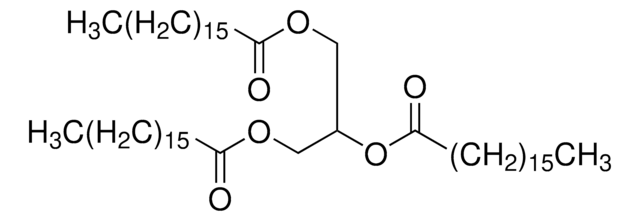S6389
1-Stearoyl-2-arachidonoyl-sn-glycerol
~98%, suitable for stimulation of protein kinase C derived from liver cells, liquid
Sinónimos:
1-Octadecanoyl-2-([cis,cis,cis,cis]-5,8,11,14-eicosatetraenoyl)-sn-glycerol, 2-Arachidonoyl-1-stearoyl-sn-glycerol
About This Item
Productos recomendados
Ensayo
~98%
Formulario
liquid
impurezas
1,3-isomer, trace
solubilidad
chloroform: 20 mg/ml
idoneidad
suitable for stimulation of protein kinase C derived from liver cells
Condiciones de envío
dry ice
temp. de almacenamiento
−20°C
cadena SMILES
CCCCCCCCCCCCCCCCCC(=O)OCC(CO)OC(=O)CCC\C=C/C\C=C/C\C=C/C\C=C/CCCCC
InChI
1S/C41H72O5/c1-3-5-7-9-11-13-15-17-19-20-22-24-26-28-30-32-34-36-41(44)46-39(37-42)38-45-40(43)35-33-31-29-27-25-23-21-18-16-14-12-10-8-6-4-2/h11,13,17,19,22,24,28,30,39,42H,3-10,12,14-16,18,20-21,23,25-27,29,31-38H2,1-2H3/b13-11-,19-17-,24-22-,30-28-
Clave InChI
NSXLMTYRMFVYNT-LGHBDAFPSA-N
¿Está buscando productos similares? Visita Guía de comparación de productos
Aplicación
Acciones bioquímicas o fisiológicas
Envase
Precaución
Código de clase de almacenamiento
10 - Combustible liquids
Clase de riesgo para el agua (WGK)
WGK 3
Punto de inflamabilidad (°F)
Not applicable
Punto de inflamabilidad (°C)
Not applicable
Equipo de protección personal
Eyeshields, Gloves, multi-purpose combination respirator cartridge (US)
Elija entre una de las versiones más recientes:
¿Ya tiene este producto?
Encuentre la documentación para los productos que ha comprado recientemente en la Biblioteca de documentos.
Los clientes también vieron
Nuestro equipo de científicos tiene experiencia en todas las áreas de investigación: Ciencias de la vida, Ciencia de los materiales, Síntesis química, Cromatografía, Analítica y muchas otras.
Póngase en contacto con el Servicio técnico















